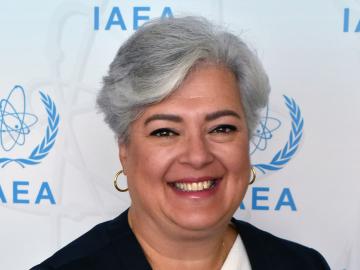Filter News
Area of Research
- (-) Clean Energy (78)
- (-) National Security (16)
- Advanced Manufacturing (1)
- Biology and Environment (44)
- Chemistry and Physics at Interfaces (1)
- Data (1)
- Energy Frontier Research Centers (1)
- Functional Materials for Energy (1)
- Fusion and Fission (7)
- Isotope Development and Production (1)
- Isotopes (9)
- Materials (34)
- Materials Synthesis from Atoms to Systems (1)
- Materials Under Extremes (1)
- Neutron Science (8)
- Nuclear Science and Technology (5)
- Renewable Energy (1)
- Sensors and Controls (1)
- Supercomputing (9)
News Type
News Topics
- 3-D Printing/Advanced Manufacturing (11)
- Artificial Intelligence (2)
- Big Data (1)
- Bioenergy (2)
- Biology (1)
- Biomedical (1)
- Buildings (6)
- Clean Water (1)
- Climate Change (3)
- Computer Science (3)
- Coronavirus (4)
- Critical Materials (1)
- Cybersecurity (6)
- Decarbonization (8)
- Energy Storage (11)
- Environment (6)
- Grid (7)
- Machine Learning (2)
- Materials (2)
- Materials Science (1)
- Mathematics (1)
- Mercury (1)
- Microscopy (1)
- National Security (11)
- Net Zero (1)
- Neutron Science (1)
- Nuclear Energy (1)
- Quantum Science (1)
- Security (4)
- Summit (1)
- Sustainable Energy (6)
- Transportation (10)
Media Contacts

As a researcher in power electronics, Shajjad Chowdhury is focused on exceeding capacity. In a lab space at the National Transportation Research Center at ORNL, he’s developing a novel capacitor and inverter component that will shrink the size and reduce the cost of electric drive units. He sees this as a potential step to increase electric vehicle adoption in the United States.

Stephen Dahunsi’s desire to see more countries safely deploy nuclear energy is personal. Growing up in Nigeria, he routinely witnessed prolonged electricity blackouts as a result of unreliable energy supplies. It’s a problem he hopes future generations won’t have to experience.

Ben Thomas recalled the moment he, as a co-op student at ORNL, fell in love with computer programming. “It was like magic.” Almost five decades later, he strives to bring the same feeling to students through education and experience in fields that could benefit nuclear nonproliferation.

Having lived on three continents spanning the world’s four hemispheres, Philipe Ambrozio Dias understands the difficulties of moving to a new place.

Materials scientist Denise Antunes da Silva researches ways to reduce concrete’s embodied carbon in the Sustainable Building Materials Laboratory at ORNL, a research space dedicated to studying environmentally friendly building materials. Credit: ORNL, U.S. Dept. of Energy

In human security research, Thomaz Carvalhaes says, there are typically two perspectives: technocentric and human centric. Rather than pick just one for his work, Carvalhaes uses data from both perspectives to understand how technology impacts the lives of people.

Though Scott Stewart recently received an Early Career Award from the Institute of Nuclear Material Management, he is regarded as a seasoned professional in the nuclear field with over 10 years of experience.

When Bill Partridge started working with industry partner Cummins in 1997, he was a postdoctoral researcher specializing in applied optical diagnostics and new to Oak Ridge National Laboratory.

Countries around the world have unique languages, cultures, food, entertainment and governments. Yet, more than 170 countries are finding common ground in an unlikely field: nuclear material and science.

When Matt McCarthy saw an opportunity for a young career scientist to influence public policy, he eagerly raised his hand.




